MARIANI’S
Virtual
Gourmet
July 23, 2017
NEWSLETTER
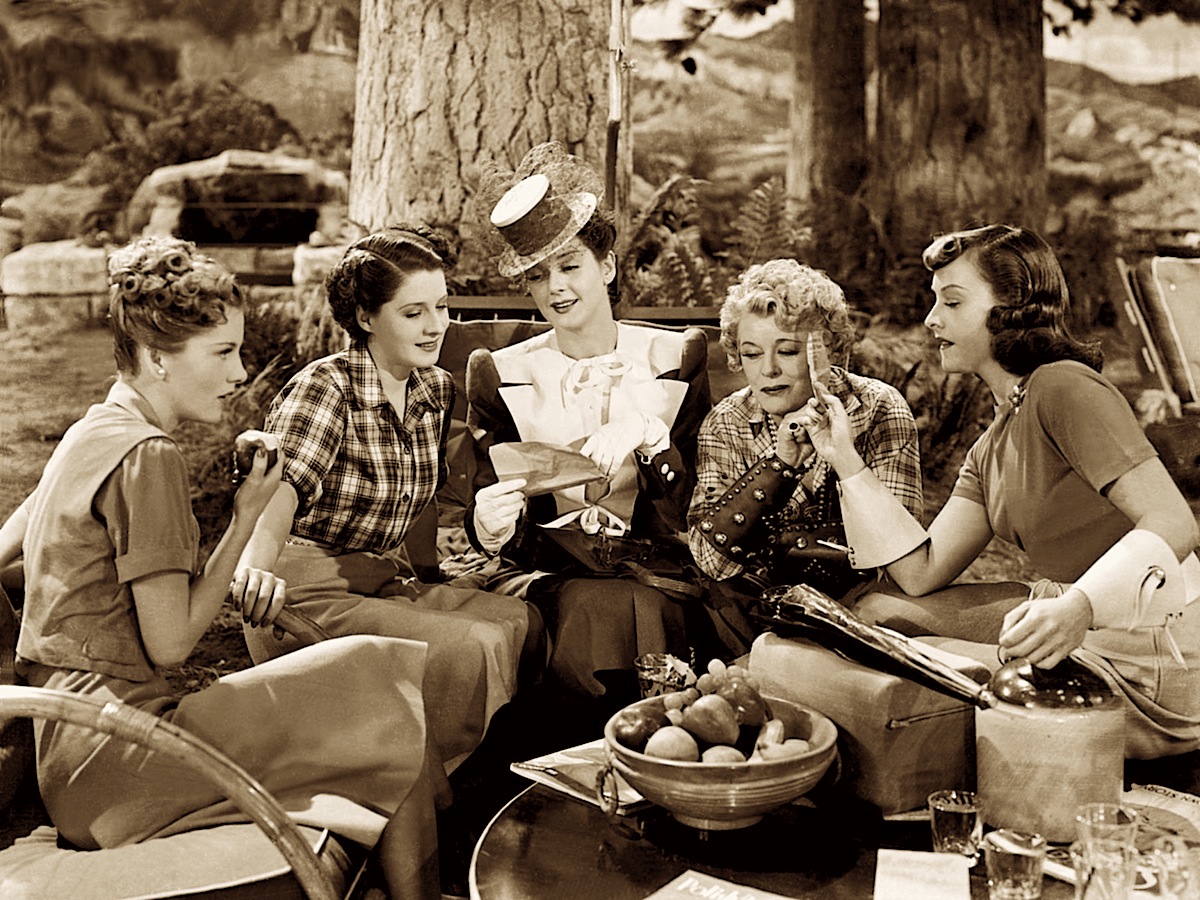
❖❖❖
IN THIS ISSUE
WHEN FLYING WAS STILL A THRILL
By John Mariani
NEW YORK CORNER
IBIZA
By John Mariani
NOTES FROM THE WINE CELLAR
THE WINES OF ROERO
By Brian Freedman
❖❖❖
WHEN FLYING WAS
STILL A THRILL
By John Mariani
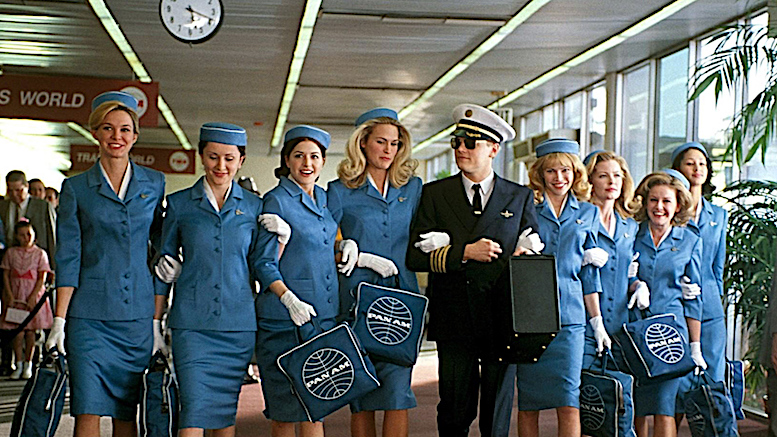
Leonardo DiCaprio in Catch Me If You Can (2002)
In
an article in the New York
Times last month (“There Was No `Golden Age’
of Air Travel”)
airline pilot Patrick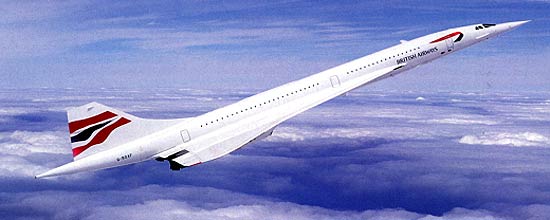 Smith makes some reasonable
points, contending “Flying Was Never Fun.” He
insists that airline ticket prices
adjusted for inflation are now cheaper
than ever, and that in the old days—he
means the 1960s through 1980s—there were
unbearably long flying times for some
routes, despite the fact that a Boeing 707
in 1958 cruised at 540 mph while today’s
new Boeing 737 does so at 564 mph. Flying
from JFK to LAX, or Boston to Paris,
in 1970 or 1980 took the same time as it
does today. The glorious Concorde (right)
crossed the Atlantic in three and a half
hours.
Smith makes some reasonable
points, contending “Flying Was Never Fun.” He
insists that airline ticket prices
adjusted for inflation are now cheaper
than ever, and that in the old days—he
means the 1960s through 1980s—there were
unbearably long flying times for some
routes, despite the fact that a Boeing 707
in 1958 cruised at 540 mph while today’s
new Boeing 737 does so at 564 mph. Flying
from JFK to LAX, or Boston to Paris,
in 1970 or 1980 took the same time as it
does today. The glorious Concorde (right)
crossed the Atlantic in three and a half
hours.
As for fares, he fails to recall that in the 1960s you could fly from LGA to DC or Boston for $12.75 on Eastern Airlines or PanAm “shuttle” flights. Charter flights to Europe could be had for as little as $200.
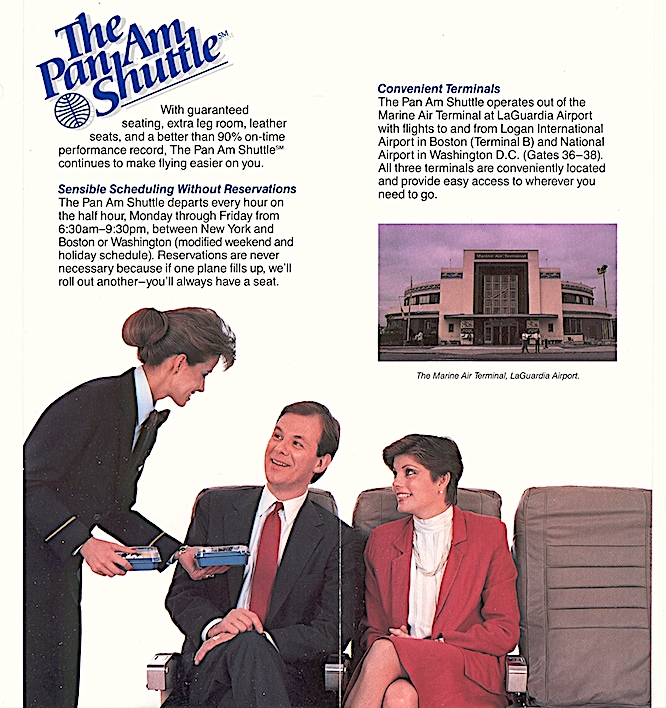 He also does not mention that in the
past you did not
pay for checked baggage, always got a
meal (such as it was), pillows and blankets,
incurred no penalty fees for changing flights or
cancellations, and, if you missed your flight on
TWA you could walk over to the PanAm or United or
American desk and use the same ticket to fly to
the same city hours or even minutes later. And, if
the shuttle flight to DC was full, they would
literally roll out another plane for late-arriving
passengers. And take your cash or credit card
onboard to pay for your ticket.
He also does not mention that in the
past you did not
pay for checked baggage, always got a
meal (such as it was), pillows and blankets,
incurred no penalty fees for changing flights or
cancellations, and, if you missed your flight on
TWA you could walk over to the PanAm or United or
American desk and use the same ticket to fly to
the same city hours or even minutes later. And, if
the shuttle flight to DC was full, they would
literally roll out another plane for late-arriving
passengers. And take your cash or credit card
onboard to pay for your ticket.
Let’s not even begin to talk about the difference
in hospitality between then and now on airlines.
To be sure, the airlines were guilty of arrant
sexism when it came to hiring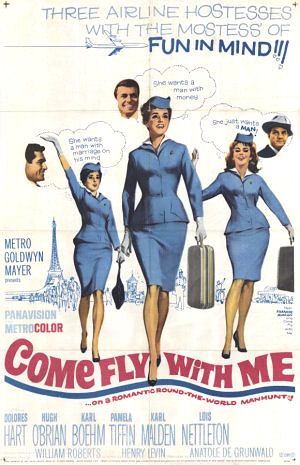 what used
to be called stewardesses, whose popular image as
the “Coffee, tea or me?” girls was quietly ignored
by airline executives, who in the 1970s dressed
their attendants in uniforms designed to look like
something on Hugh Hefner’s Bunny Jet. The
airlines seemed more than content with the image
purveyed in dreadful sex farces like Come Fly
with Me (1963) and Boeing-Boeing
(1965). Women
could not be married and, if they got pregnant,
they were fired.
But by the 1980s most of that sexism had
disappeared; it was also around 1980 that male
flight attendants began to be hired.
what used
to be called stewardesses, whose popular image as
the “Coffee, tea or me?” girls was quietly ignored
by airline executives, who in the 1970s dressed
their attendants in uniforms designed to look like
something on Hugh Hefner’s Bunny Jet. The
airlines seemed more than content with the image
purveyed in dreadful sex farces like Come Fly
with Me (1963) and Boeing-Boeing
(1965). Women
could not be married and, if they got pregnant,
they were fired.
But by the 1980s most of that sexism had
disappeared; it was also around 1980 that male
flight attendants began to be hired.
Nevertheless,
anyone who flew back in those days can surely
agree about the general tenor of hospitality among
those flight attendants. Smiling, comforting, ever
willing to answer questions about delays and
transfers, flight attendants did indeed attend to
the needs of passengers, who were often in a state
of anxiety, exhaustion or just plain orneriness. Children
were always pampered, even to 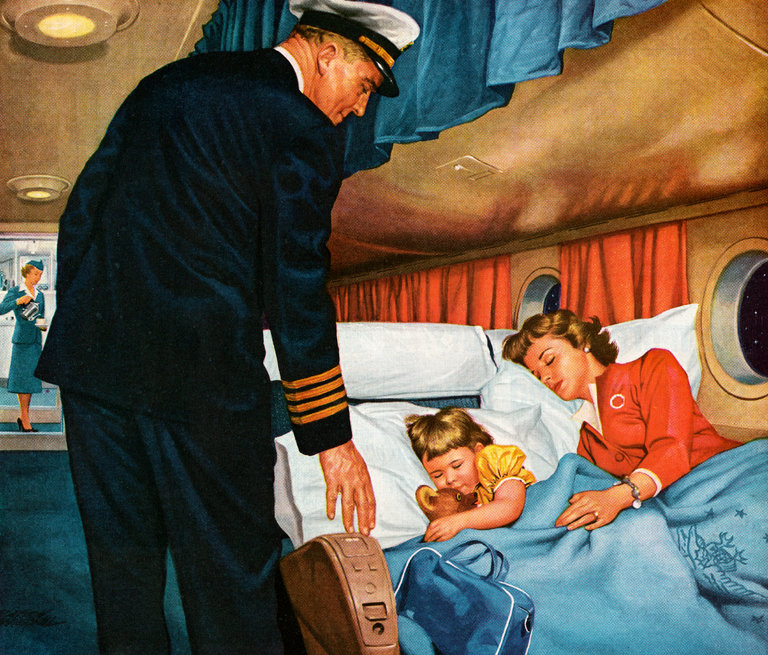 the point of being
allowed to visit the captain’s cabin. I
recall my young son being invited up to the cabin
of the Concorde for ten minutes or more while I
dozed off. Today
those cabins are, for good reason, bolted shut and
impregnable.
the point of being
allowed to visit the captain’s cabin. I
recall my young son being invited up to the cabin
of the Concorde for ten minutes or more while I
dozed off. Today
those cabins are, for good reason, bolted shut and
impregnable.
Back then flight attendants, who often checked you in at the gate, were empowered—or allowed—to bump passengers up to first class, usually people who presented themselves in a very courteous manner, but more often than not a passenger with a small child or a disabled person. Now, such graciousness is wholly forbidden.
Flying really was a thrill for first-timers and
distinctly glamorous, especially when the jet age
begat the idea of the Jet Set and Frank Sinatra
singing seductively, “Come fly with me, let’s fly,
let’s fly away/ If you can use some exotic booze/
There’s a bar in far Bombay.” Most
people dressed up to travel by air; people even
dressed up to drive friends to the airport. 
There always have been delays owing to weather and mechanical problems, but the routine scheduling of a dozen or more planes to take off at exactly the same time from the same runway was prohibited when the airlines were regulated. I don’t recall ever sitting on the tarmac for more than two hours as I recently did on a flight from JFK to Orly, not because Air France was guilty of delay but because the entire airport was loaded up with flights all due to take off at the same moment. You also didn’t get ETAs back then saying that a two-hour flight would take three and a half hours, because delays are now deceptively built into the flight info, so that a flight that actually takes only two hours is given an ETA of three-and-a-half to allow for all the time on the tarmac and other delays at both ends.
 Through no fault of the
airlines, terrorism has made flying one of the
very worst modes of travel imaginable now, with
hour-long waits on security and passport control
lines normal at international terminals. The fact
is, the terrorists have already won, costing the
airlines trillions of dollars, which we pay for,
in extra security measures. In the
old days there was no such thing. Friends
could see you off right at the gate and give you
packages to bring onboard. Parents
could go onboard with a small child traveling
alone and hand her off to a very affable flight
attendant. When
you got to your destination, your friends met you
as you exited the plane.
Through no fault of the
airlines, terrorism has made flying one of the
very worst modes of travel imaginable now, with
hour-long waits on security and passport control
lines normal at international terminals. The fact
is, the terrorists have already won, costing the
airlines trillions of dollars, which we pay for,
in extra security measures. In the
old days there was no such thing. Friends
could see you off right at the gate and give you
packages to bring onboard. Parents
could go onboard with a small child traveling
alone and hand her off to a very affable flight
attendant. When
you got to your destination, your friends met you
as you exited the plane.
I recall a so-so Kirk Douglas movie called Two Weeks in Another Town wherein Douglas, realizing the errors of his ways as a besotted director making a movie in Rome, races to the airport to catch the next flight back to the U.S. only to find the plane is just closing its doors. Douglas pays for a ticket in cash, flashes his passport at the gate and the attendant waves him through. He runs onto the tarmac and bounds up the stairway to the plane, they open the door. He gets a big hug and kiss from co-star Daliah Lavi as the plane’s engines come to life. Such a scenario was not hokey Hollywood: it could happen to you. In the Golden Age of Flight.
❖❖❖
By John Mariani
93 Mill Plain Rd.
Danbury, CT
203-616-5731
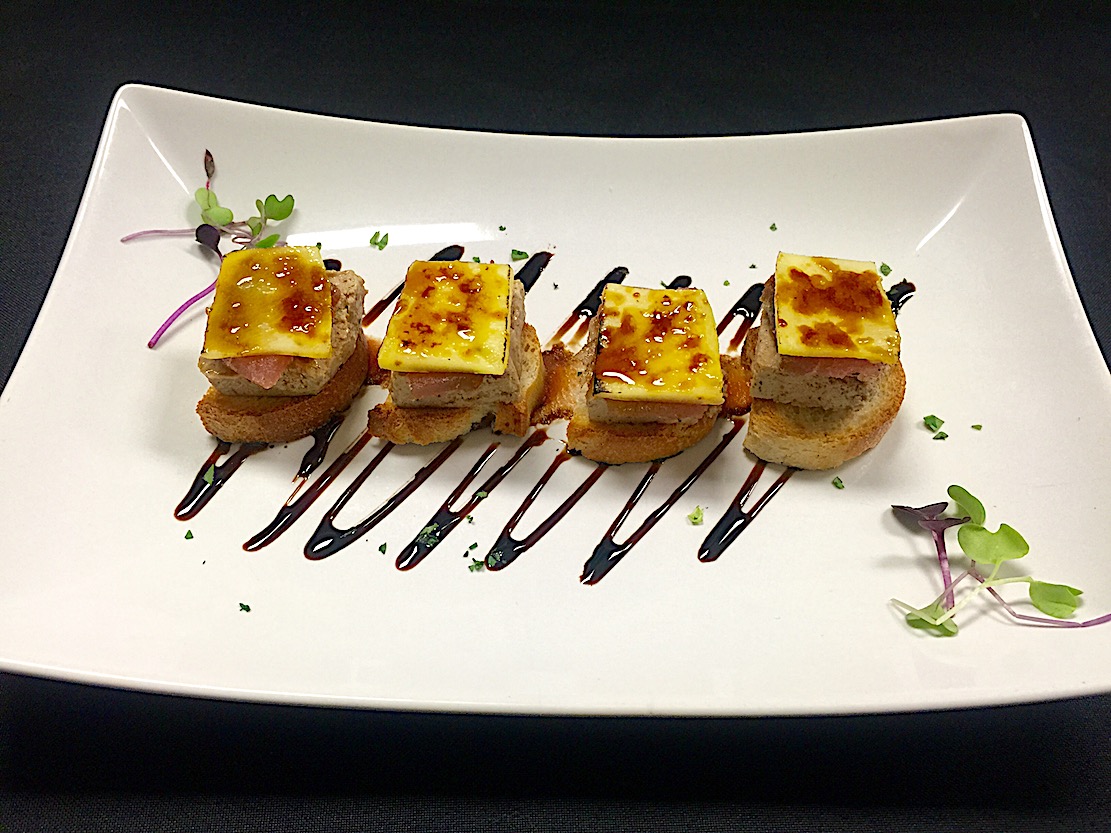
Last week I wrote about an elegant restaurant on Connecticut’s wealthy Gold Coast named Rebeccas; this week I turn to the far less affluent town of Danbury to write of an outstanding Spanish tapas restaurant in a strip mall that includes a Panda House, a Middle Eastern restaurant called Kibberia and The Secret Hair Salon. Put that aside and enter into a large, colorful dining room with red walls, modern op-art-style murals and the night’s specials posted on blackboards. The tables are black and there is a long bar.
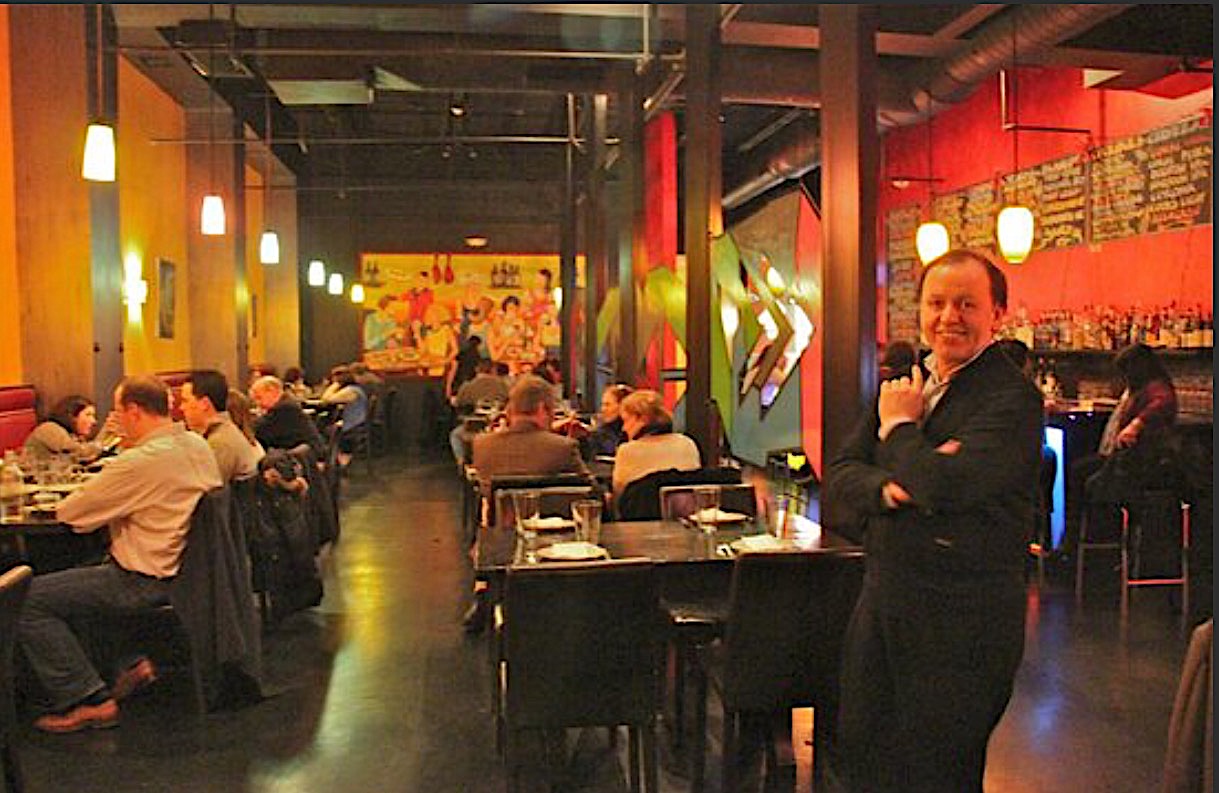 The real color is on the plates at
Ibiza, named for the resort island off the coast
of Spain. The
array of tapas
is daunting, many in the traditional style
you’ll find in any tapas (or pintxos)
bar in Barcelona or San Sebastian, while others
are very modern and beautifully composed to be
true eye candy.
The real color is on the plates at
Ibiza, named for the resort island off the coast
of Spain. The
array of tapas
is daunting, many in the traditional style
you’ll find in any tapas (or pintxos)
bar in Barcelona or San Sebastian, while others
are very modern and beautifully composed to be
true eye candy.
For two decades now Ignacio Blanco (left) has been a trailblazer in America for modern Spanish cuisine, first in TriBeCa at Meigas (put out of business after 9/11) and other restaurants he’s opened in Connecticut. The current Ibiza, opened in 2013, is one of his finest efforts, and there simply is no more affable host than he, ever passionate about introducing you to, or adding to your knowledge of, a style of food that is, as he says, a way of life in Spain.
For that reason, and since most dishes are under
$10, it’s a good idea to put yourself in Blanco’s
hands and have him and Chef Gilbert Trejo choose
until you cry, “no mas!” The
menu is divided into “From the Sea,” “From the
Farm,” and “Raciones”
(portions).
Everything—and this is not usually the case
with typical tapas
bars—is beautifully presented on an array of china
dishware.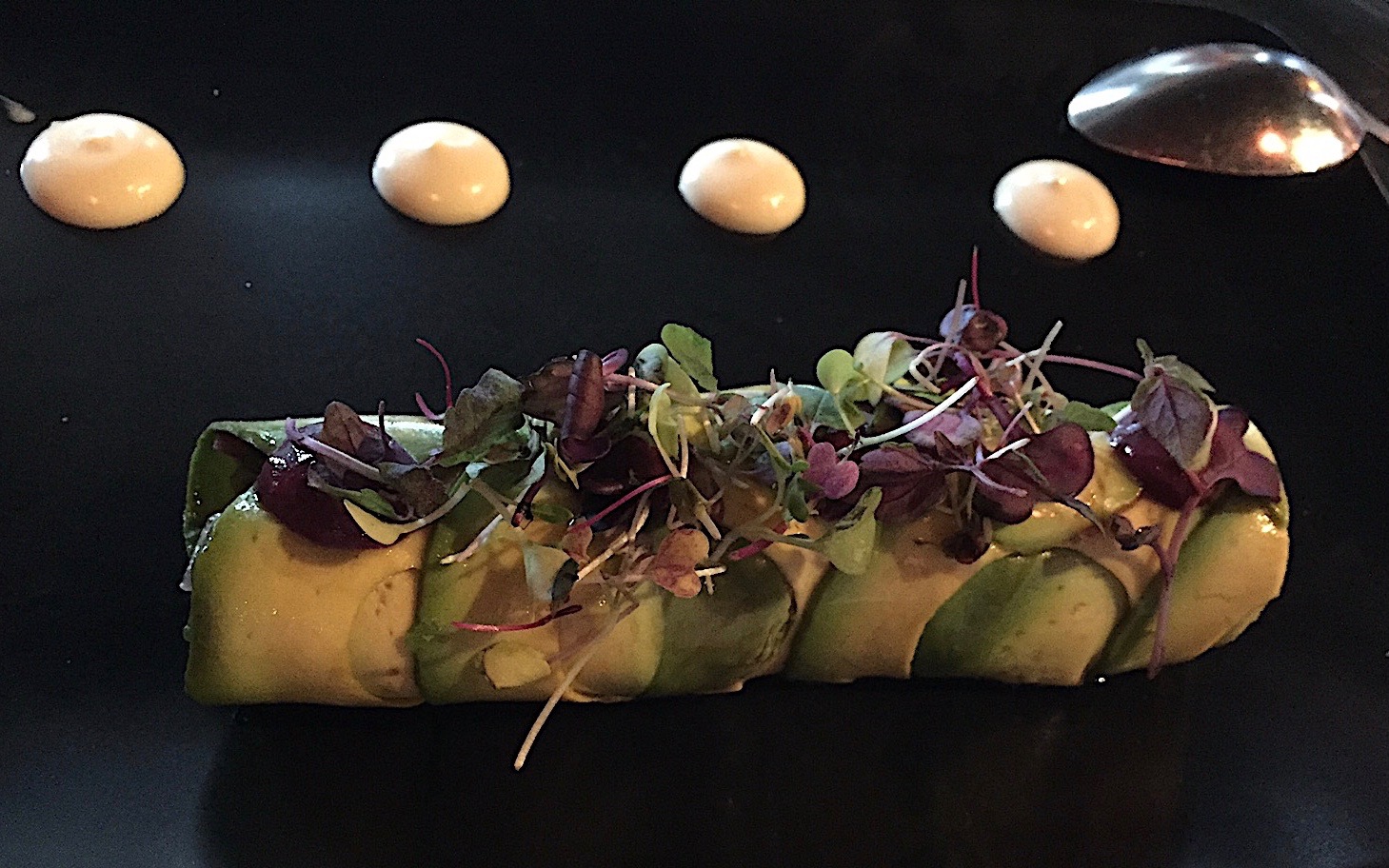
Begin with the blue fin tuna with sesame oil, black olives, scallions, diced tomato, lemon and Ibiza sea salt ($12)—an array of flavors—or, if you like marinated anchovies (boquerones), at Ibiza they are embellished with olive oil toast, avocado and black olive tapenade ($8). Gambas are large shrimp with delicate sliced garlic, olive oil, lemon, Guindilla and parsley ($12), while velvety pulpo (steamed octopus) takes on the wonderful aromas of smoked Spanish paprika potatoes, extra virgin olive oil and Ibiza sea salt ($13). The calamares are from local waters, with sweet caramelized onions and a Galician vinaigrette ($12).
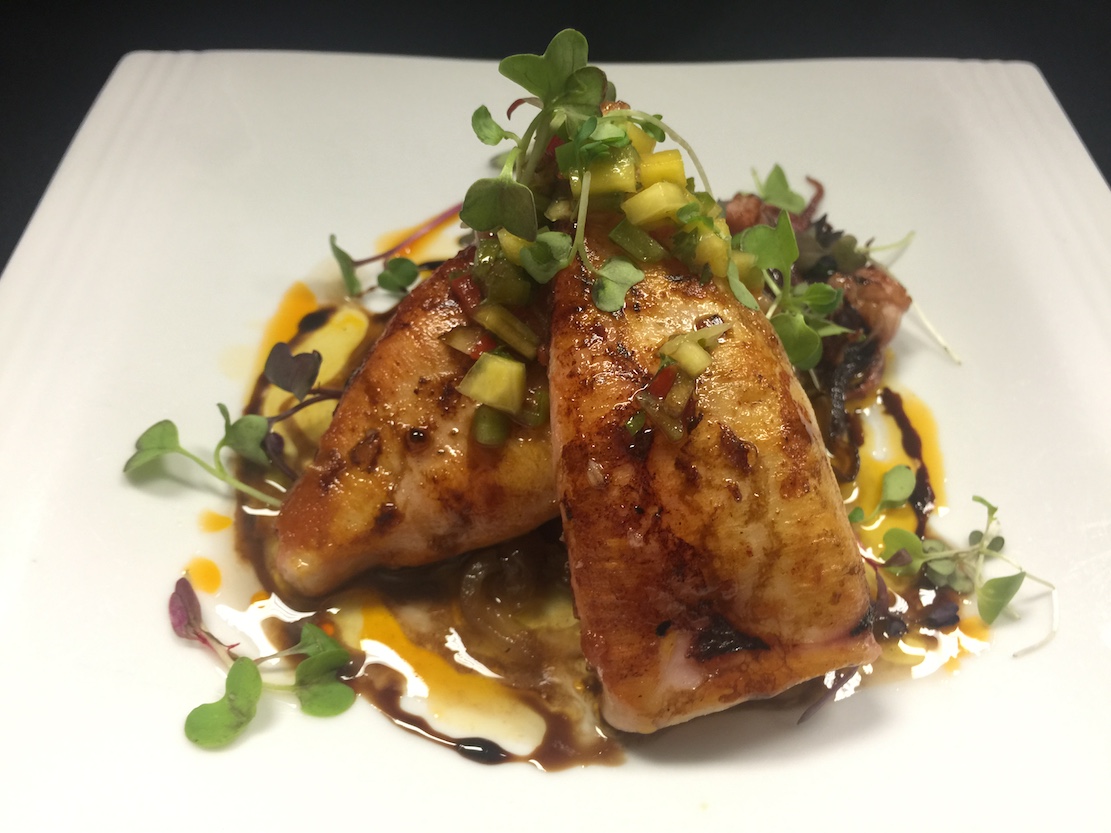 The
“farm” dishes include lomo
marinated pork loin, Tetilla cheese, black
olives, tomato and scallions on toast ($9.50), and
marvelous crispy cannelloni of braised local baby
lamb shank, tomato, scallions, black olives and
sweet potato puree ($10). The sobreasada Mallorcan
sausages are made in house and served with
caramelized green apple ($9), and of particular
interest—and unusual in a tapas
bar—is foie gras and pistachio nougat, tomato
marmalade and caramelized mango on toast ($10).
There are even hamburger sliders made from
succulent short ribs,
rib eye and foie gras with caramelized onions
and a BBQ aïoli ($10).
The
“farm” dishes include lomo
marinated pork loin, Tetilla cheese, black
olives, tomato and scallions on toast ($9.50), and
marvelous crispy cannelloni of braised local baby
lamb shank, tomato, scallions, black olives and
sweet potato puree ($10). The sobreasada Mallorcan
sausages are made in house and served with
caramelized green apple ($9), and of particular
interest—and unusual in a tapas
bar—is foie gras and pistachio nougat, tomato
marmalade and caramelized mango on toast ($10).
There are even hamburger sliders made from
succulent short ribs,
rib eye and foie gras with caramelized onions
and a BBQ aïoli ($10).
Tapas bars are not known for their desserts, but
Ibiza does not cut back on its creativity in
lovely items like torrija
moderna, a crispy bread pudding with vanilla
ice cream and sweet and sour strawberry sauce ($9);
the dazzlingly rich tres
leches cake with banana foam and sweet and
sour kumquat ($8); 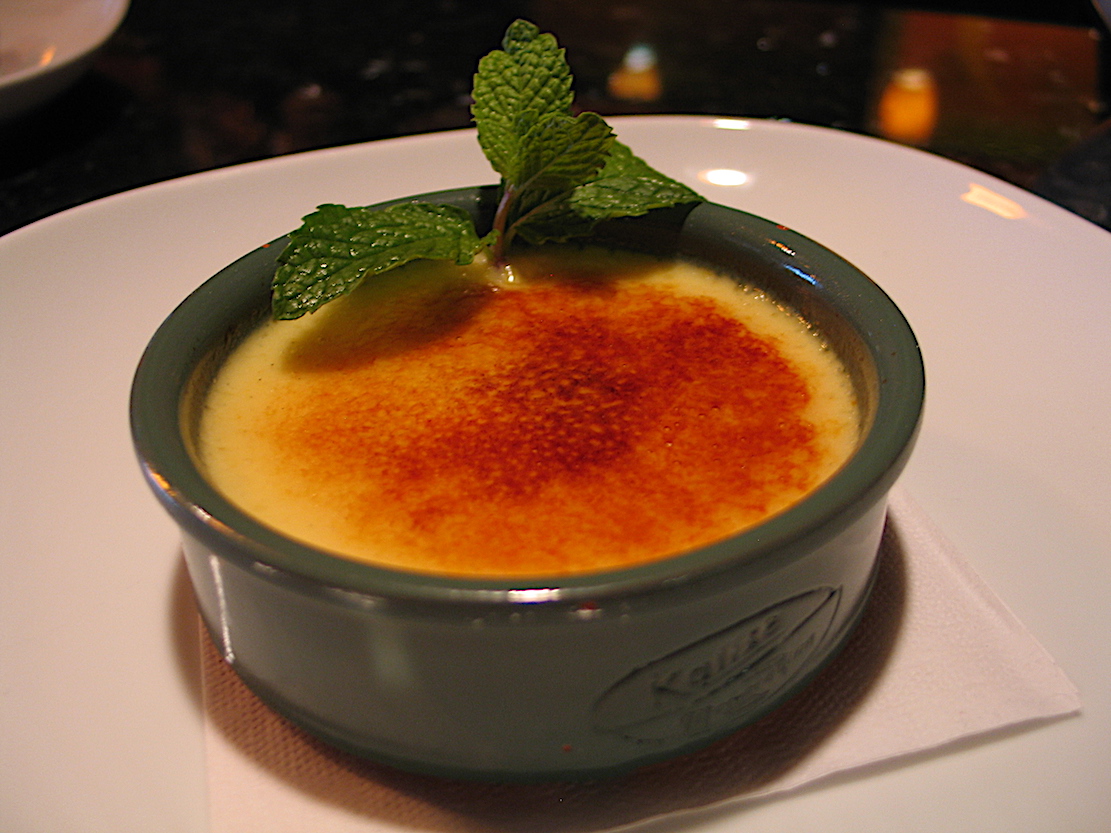 a true Crema
Catalana ($8.50; right); and plump chocolate croquetas
with crushed almonds, coconut foam and lime
gelatin ($8).
Even a simple rice pudding is lavished
with chocolate mousse and orange foam ($8).
a true Crema
Catalana ($8.50; right); and plump chocolate croquetas
with crushed almonds, coconut foam and lime
gelatin ($8).
Even a simple rice pudding is lavished
with chocolate mousse and orange foam ($8).
Beer and Txocali sparkling wine is the usual beverage in tapas bars, but Ibiza has an impressive Spanish wine list that marries to its food, with dozens of bottles under $40.
New York City has a few good tapas bars, though they tend to be frenetic, loud and pricey. Ibiza, for all its color and focus on the unusual fitted into the traditional, is to my mind better than any in Manhattan. For that reason a true aficionado of Spanish food should make the trip to Danbury and be amazed.
Ibiza is open for dinner Tues.-Sun.
❖❖❖
By Brian Freedman
In the lead-up to my visit to Roero
this past November, I made a point of limiting
my white wine consumption at home. Why would I
pop corks of white in Philadelphia when, once I
arrived, I’d surely be inundated by a veritable
tidal wave of it?
Roero, after all, is home to some of the
best white wine in Italy, and in recent years,
the reputation of Roero Arneis has been gaining
more-than-justified traction in the United
States. It
typically boasts expressive fruit, structured
acidity, and the quality-to-price ratio is hard
to beat.
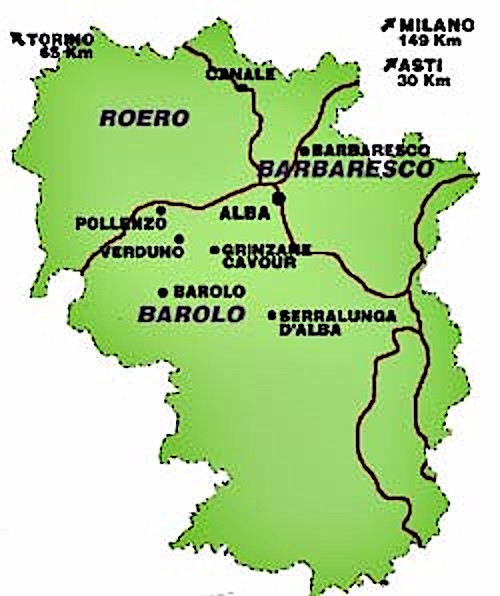 Turns out I was wrong. Not about
Arneis, however. It was every bit as excellent as
I’d expected. Tasting examples from some of the
top producers in the region absolutely reaffirmed
my conviction that it’s a wine that has only just
begun its ascent to the upper echelons of
recognition and popularity.
Turns out I was wrong. Not about
Arneis, however. It was every bit as excellent as
I’d expected. Tasting examples from some of the
top producers in the region absolutely reaffirmed
my conviction that it’s a wine that has only just
begun its ascent to the upper echelons of
recognition and popularity.
I was wrong, rather, about what I’d find there.
That’s because the reds were undoubtedly every bit
as exciting, and as eye-opening, as those whites.
Which makes sense, given Roero’s proximity to
Barolo and Barbaresco, home to some of the most
famous reds in Italy. Still, like so many other
world-class wine regions that neighbor more famous
ones, Roero doesn’t necessarily reap huge benefits
from that proximity. Located not all that far
across the Tanaro River, it still resides in the
proverbial shadow of its neighbors.
But it doesn’t deserve to; not even close. That’s
because the wine culture of Roero is vibrant,
forward-thinking yet rooted in a real respect for
the past, and deeply honest in its efforts to
express the unique terroir it’s blessed with, and
the wines coming out of there right now possess
exactly the sort of shimmering expressiveness that
only the most exciting DOCs and DOCGs typically
do, and that consumers increasingly look for.
After having spent some time there, I came away
firmly convinced that Roero has everything it
takes to become the proverbial “next big thing” in
Italian wines.
There are DOCGs
in Roero for both the Arneis and Nebbiolo grape
varieties, the former comprising both Roero Arneis
and Roero Arneis Spumante, and the latter Roero
and Roero Riserva. With all four of these, I came
away with a brand new
appreciation for what Roero is capable of. This
was driven home my first morning there, when I had
the insanely good fortune of tasting the Cornarea Arneis di
Canale 1983, a wine that was harvested
only six years after I was born, and that, even
now, 34 years later, was frankly more energetic
than I felt after my red-eye flight to Italy. It
was a transformative wine, with butterscotch
countered by smoky minerality, by dried apple
anchored by a sense of torrefaction, by lemon curd
and white fig edged with eucalyptus and saffron.
And 1983, I was told, wasn’t even a great vintage!
Of course, the
chances of finding a three-and-a-half-decade-old
Arneis on the American market are slim at best,
but the point was clear: When grown and crafted
with care, Arneis from Roero has the potential to
age brilliantly.
As so many other
bottlings showed, it also justifies its reputation
for delicious early drinking as well. A vertical
at the fantastic Cascina
Pace was a game-changing experience,
their 2015 Roero Arneis rich and honeyed yet with
lots of mineral and crunchy pear notes anchoring
it all. Pace’s 2013 was maturing brilliantly, with
hints of warm almonds and more balsamic notes. The
2012, dense and concentrated yet lifted with
citrus oils and white peach, boasted additional
flavors of minerals and flowers—it was a
show-stopper. And the 2010, with its baked stone
fruit, apple fritters, and
still-wonderfully-concentrated richness, showed
the more savory side of Roero Arneis, that same
seam of minerality that I’d by then come to expect
lending it further structure and elegance.
As the market for high-quality Roero Arneis
continues to grow, I expect to see the same broad
range of expressions of it in the American market
as I did in Piedmont, as well as an appreciation
for the other excellent wines coming out of Roero
itself. This includes reds, rosés, and sparklers,
too.
The reds, as I mentioned, constitute some truly
remarkable expressions of Nebbiolo. And, depending
on where in Roero they are being grown, and the
winemaking goals of who is crafting them, the
various bottlings exhibit a stunning swath of
diverse styles—though for all of their
differences, my impression was that, in general,
but with some exceptions, they’re a bit more
giving in the glass early on than their
counterparts in Barolo and Barbaresco. One, of
course, is not better than the other, and again,
there are exceptions. On the whole, I found wines
labeled Roero DOCG and Roero Riserva DOCG
friendlier than young Nebbiolo-based wines are
typically perceived as being, yet still with the
benefit of being worthy of laying down in the
cellar.
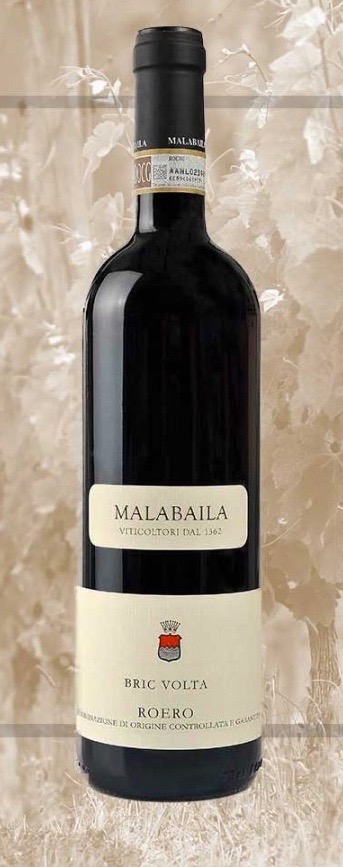 Malabaila’s Roero
“Bric Volta” 2013, for example, was
electrically fresh and expressive, with red
cherries, mint, and a hint of rose petals that
were delicious immediately, but the undertow of
leather, tobacco, and charred wild mushrooms
promise another two decades of potential aging. Cascina Val del
Prete’s Roero “Bricco Medica” 2013 was
impeccably structured with tea-like tannins and
excellent acidity, flashed with Indian spices and
wild strawberries. From Antica Cascina dei Conti di Roero,
I swooned over the Roero 2011, which leverages new
and second-use barriques to result in a wine with
star anise, sweet black licorice, and dark
cherries. I’d happily drink it now and for another
decade.
Malabaila’s Roero
“Bric Volta” 2013, for example, was
electrically fresh and expressive, with red
cherries, mint, and a hint of rose petals that
were delicious immediately, but the undertow of
leather, tobacco, and charred wild mushrooms
promise another two decades of potential aging. Cascina Val del
Prete’s Roero “Bricco Medica” 2013 was
impeccably structured with tea-like tannins and
excellent acidity, flashed with Indian spices and
wild strawberries. From Antica Cascina dei Conti di Roero,
I swooned over the Roero 2011, which leverages new
and second-use barriques to result in a wine with
star anise, sweet black licorice, and dark
cherries. I’d happily drink it now and for another
decade.
Negro Angelo &
Figli’s Roero Riserva “Ciabót San Giorgio” 2013
sings with black raspberries, sappy cherries, and
a hint of rose petal, all structured with sweet,
rich tannins. Demarie,
with their Roero “Famiglia” 2011, has produced a
wine exclusively for the American market that
leverages 70% new American oak and 30% new French
oak. It is worth seeking out, its blackberry,
cigar tobacco, and toasty vanilla notes promising
to continue to integrate and gain complexity for
the next 15 years or more.
Not all Nebbiolo goes into the DOCG bottlings, and
there are plenty of great ones that are labeled
differently. Costa
Catterina’s Nebbiolo d’Alba Superiore 2014 is
a delicious example, with gobs of ripe
strawberries and tobacco notes, all framed by very
elegant tannins. Cornarea’s Nebbiolo d’Alba 2014
is excellent right now as well, with brambly berry
and floral notes lending it lift.
And then there’s Barbera, which I hadn’t expected
to be as impressed with as I was. After all,
except for a few notable exceptions, Barbera is
typically perceived in the United States as a
pleasant and food-friendly wine that is meant
mainly for early consumption. But wines like the Monchiore Carbone
Barbera d’Alba “Mon Birone” 2013
practically vibrated in the glass with wild
mushrooms, spicy blue and purple berries, and
flavors of spice- and mineral-tinged fruit, all
bright with beautifully balanced acidity. I’d buy
a case of this and happily drink it over the next
10 years. They also produce a stunning
single-vineyard Roero, called “Srü”; the
2013 was savory and assertive, with fine-grained
tannins structuring forest floor and porcini
notes, as well as a sea-shell-like minerality to
the ripe strawberries. Massucco’s Barbera d’Alba “Serra” 2013,
with its bright acidity and the subtle herbal hint
to the concentrated fruit, would be a great
addition to any dinner table. Cascina Val del
Prete’s Barbera d’Alba “Serra de’ Gatti” 2015,
from a young single vineyard with a high
percentage of sand, shimmered with bing cherry and
bright acidity.
Matteo Correggia
wowed me with so much of what we tasted,
notably their Barbera d’Alba 2014, with its
concentrated, generous berry fruit and remarkably
reasonable pricing, and the unexpected yet winning
Le Marne Grigie
2012, a blend of Cabernet Sauvignon,
Cabernet Franc, Syrah, Petit Verdot, and Merlot
that was balanced and expressive with currants,
blackberries, sage, and minerality. 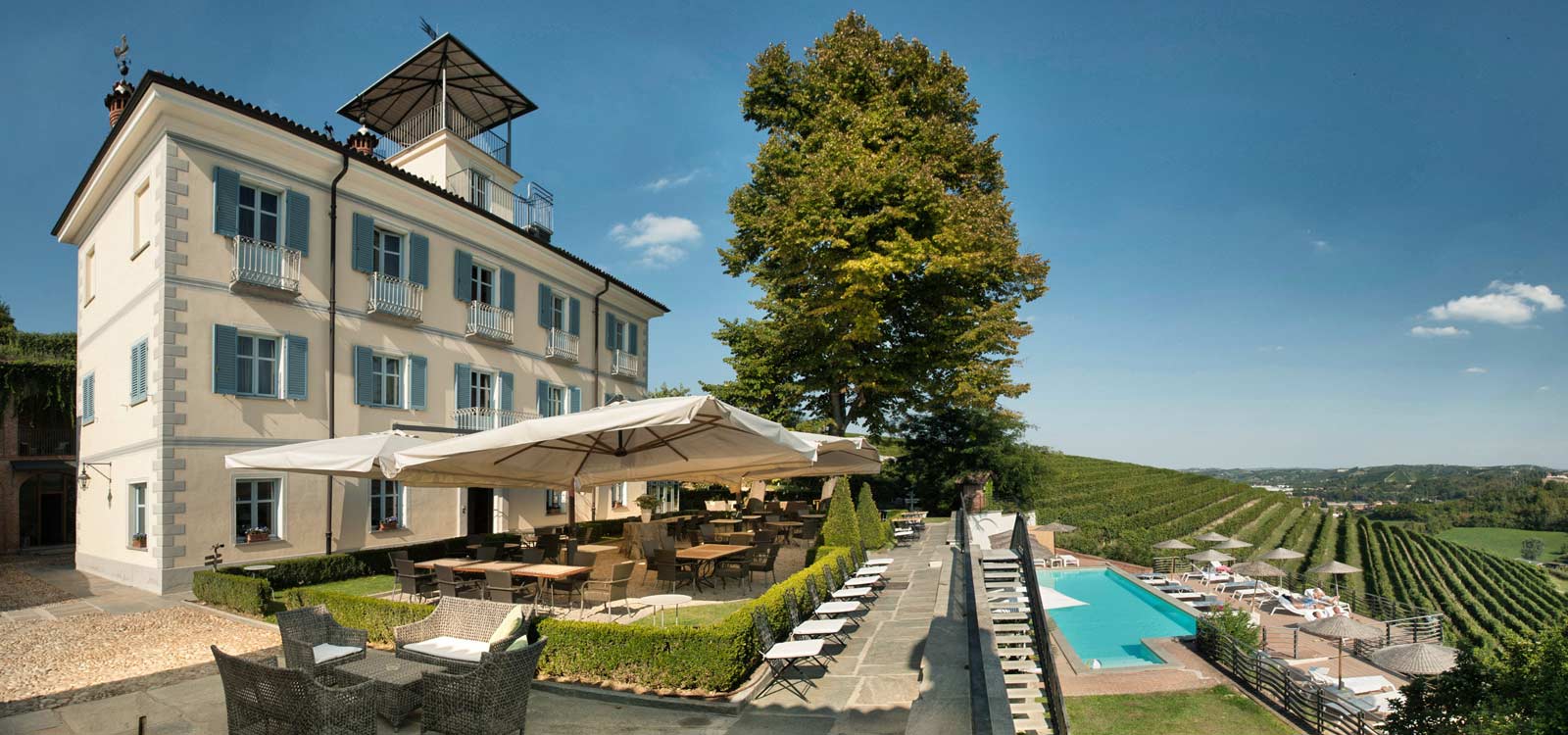 Malvirà also produces a
unique blend, “Treuve,” which brings together
Chardonnay, Sauvignon Blanc, and Arneis; the 2009
zipped along with persimmons, apples, and honey.
Malvirà also produces a
unique blend, “Treuve,” which brings together
Chardonnay, Sauvignon Blanc, and Arneis; the 2009
zipped along with persimmons, apples, and honey.
For something more classic
from Malvirà, I’d head to their amazing Villa Tiboldi, in
Canale (right), for a great meal at the
restaurant (below),
possibly a stay of a night or three, and drink
lots of Roero Arneis “Trinità” 2013, whose sandy
soils of origin lend it a fresh, almost perfumed
character, with jasmine and minerality to spare.
Malvirà also produces Roero Riserva “Trinità,” and
the 2009 and 2000 vintages were also excellent.
Order them if you visit.
Rosé, or rosato,
also does brilliantly in Roero, which makes sense
given how successful the Nebbiolo is. Cascina Pace’s
Rosanebbia Vino Rosato 2015, which is
crafted from 100% Nebbiolo, was delicious and
detailed, with an impeccable balance between fruit
and more floral notes, the lovely red berries
dancing side by side with an anchoring earthy hint
of mushrooms and mineral. For a just-as-remarkable
expression of Nebbiolo from Cascina Pace, I
recommend the Roero Riserva 2011, maturing
beautifully with black cherries, creme de cassis,
tobacco, spice, and a gorgeous hint of earthiness.
 Roero,
indeed, is on the ascent. From white and red to rosato
and sparkling wines, this is a part of Piedmont
that is poised for its star turn. The quality is
there, the producers are passionate and creative,
and the wines typically represent fabulous value
for the money—at all price points. When I was
invited by the Consorzio to visit, I had assumed
that my time there would mostly reaffirm my
already high opinion of Roero. Instead, that visit
expanded it a thousandfold. And with wines and
grape varieties that made me thirsty for much,
much more.
Roero,
indeed, is on the ascent. From white and red to rosato
and sparkling wines, this is a part of Piedmont
that is poised for its star turn. The quality is
there, the producers are passionate and creative,
and the wines typically represent fabulous value
for the money—at all price points. When I was
invited by the Consorzio to visit, I had assumed
that my time there would mostly reaffirm my
already high opinion of Roero. Instead, that visit
expanded it a thousandfold. And with wines and
grape varieties that made me thirsty for much,
much more.
❖❖❖
 GEE, WE THOUGHT THAT WAS JOHN BELUSHI
GEE, WE THOUGHT THAT WAS JOHN BELUSHI
David Bouhadana (right), chef-owner of Sushi by Bou in NYC calls
himself “the new face
of sushi,” despite the fact that he is
white.
During service, he switches from speaking Japanese to
English with a fake Japanese intonation, as “little fun jokes,” which he likens to
how the Japanese chefs who work for him use an American
accent while quoting Drake songs. “Maybe in my mind I
think I’m Japanese,” he said.
AND YES I SAID YES I WILL YES!
“Atop Mr. Gene’s Chicago
dog lies a symphony of flavor, the panoply of
ingredients pile to crescendo. The foundation: a meaty,
rich all-beef hotdogs and blandly sweet untoasted egg
bun. Layer in the cool juice of tomato, watery crunch
from diced onion, the soft snap of dill pickle, a
vinegary schmear of yellow mustard, a hint of clove from
the onion relish, a sharp but mellow heat from Serrano
peppers, and the vaginal salinity of celery salt.
there’s so much going on you might have to order another
one to figure it all out.”—“Chicago Dog: Mr. Gene’s Dog
House,” Cincinnati
Magazine (7/17).
Any of John Mariani's books below may be ordered from amazon.com.
 The
Hound in Heaven (21st Century Lion Books)
is a novella, and for anyone who loves dogs,
Christmas, romance, inspiration, even the supernatural, I
hope you'll find this to be a treasured favorite.
The story concerns how, after a New England teacher,
his wife and their two daughters adopt a stray puppy found
in their barn in northern Maine, their lives seem full of
promise. But when tragedy strikes, their wonderful dog
Lazarus and the spirit of Christmas are the only things
that may bring his master back from the edge of
despair.
The
Hound in Heaven (21st Century Lion Books)
is a novella, and for anyone who loves dogs,
Christmas, romance, inspiration, even the supernatural, I
hope you'll find this to be a treasured favorite.
The story concerns how, after a New England teacher,
his wife and their two daughters adopt a stray puppy found
in their barn in northern Maine, their lives seem full of
promise. But when tragedy strikes, their wonderful dog
Lazarus and the spirit of Christmas are the only things
that may bring his master back from the edge of
despair. WATCH THE VIDEO!
“What a huge surprise turn this story took! I was completely stunned! I truly enjoyed this book and its message.” – Actress Ali MacGraw
“He had me at Page One. The amount of heart, human insight, soul searching, and deft literary strength that John Mariani pours into this airtight novella is vertigo-inducing. Perhaps ‘wow’ would be the best comment.” – James Dalessandro, author of Bohemian Heart and 1906.
“John Mariani’s Hound in Heaven starts with a well-painted portrayal of an American family, along with the requisite dog. A surprise event flips the action of the novel and captures us for a voyage leading to a hopeful and heart-warming message. A page turning, one sitting read, it’s the perfect antidote for the winter and promotion of holiday celebration.” – Ann Pearlman, author of The Christmas Cookie Club and A Gift for my Sister.
“John Mariani’s concise, achingly beautiful novella pulls a literary rabbit out of a hat – a mash-up of the cosmic and the intimate, the tragic and the heart-warming – a Christmas tale for all ages, and all faiths. Read it to your children, read it to yourself… but read it. Early and often. Highly recommended.” – Jay Bonansinga, New York Times bestselling author of Pinkerton’s War, The Sinking of The Eastland, and The Walking Dead: The Road To Woodbury.
“Amazing things happen when you open your heart to an animal. The Hound in Heaven delivers a powerful story of healing that is forged in the spiritual relationship between a man and his best friend. The book brings a message of hope that can enrich our images of family, love, and loss.” – Dr. Barbara Royal, author of The Royal Treatment.
 |
The Encyclopedia of American Food and Drink by John F. Mariani (Bloomsbury USA, $35) Modesty forbids me to praise my own new book, but let me proudly say that it is an extensive revision of the 4th edition that appeared more than a decade ago, before locavores, molecular cuisine, modernist cuisine, the Food Network and so much more, now included. Word origins have been completely updated, as have per capita consumption and production stats. Most important, for the first time since publication in the 1980s, the book includes more than 100 biographies of Americans who have changed the way we cook, eat and drink -- from Fannie Farmer and Julia Child to Robert Mondavi and Thomas Keller. "This book is amazing! It has entries for everything from `abalone' to `zwieback,' plus more than 500 recipes for classic American dishes and drinks."--Devra First, The Boston Globe. "Much needed in any kitchen library."--Bon Appetit. |
"Eating Italian will never be the same after reading John Mariani's entertaining and savory gastronomical history of the cuisine of Italy and how it won over appetites worldwide. . . . This book is such a tasteful narrative that it will literally make you hungry for Italian food and arouse your appetite for gastronomical history."--Don Oldenburg, USA Today. "Italian
restaurants--some good, some glitzy--far
outnumber their French rivals. Many of
these establishments are zestfully described
in How Italian Food Conquered the World, an
entertaining and fact-filled chronicle by
food-and-wine correspondent John F.
Mariani."--Aram Bakshian Jr., Wall Street
Journal.
"Equal parts
history, sociology, gastronomy, and just
plain fun, How Italian Food Conquered the
World tells the captivating and delicious
story of the (let's face it) everybody's
favorite cuisine with clarity, verve and
more than one surprise."--Colman Andrews,
editorial director of The Daily
Meal.com. "A fantastic and fascinating
read, covering everything from the influence
of Venice's spice trade to the impact of
Italian immigrants in America and the
evolution of alta cucina. This book will
serve as a terrific resource to anyone
interested in the real story of Italian
food."--Mary Ann Esposito, host of PBS-TV's
Ciao
Italia. "John Mariani has written the
definitive history of how Italians won their
way into our hearts, minds, and
stomachs. It's a story of pleasure over
pomp and taste over technique."--Danny Meyer,
owner of NYC restaurants Union Square
Cafe, The Modern, and Maialino.
|
 |
 |
 |
 |
 |
 |
 |
 |
 Everett Potter's Travel Report:
Everett Potter's Travel Report: 
 Eating Las Vegas
JOHN CURTAS has been covering the Las Vegas
food and restaurant scene since 1995. He is
the co-author of EATING LAS VEGAS – The 50
Essential Restaurants (as well as
the author of the Eating Las Vegas web site: www.eatinglasvegas.
He can also be seen every Friday morning as
the “resident foodie” for Wake Up With the
Wagners on KSNV TV (NBC) Channel 3 in
Las Vegas.
Eating Las Vegas
JOHN CURTAS has been covering the Las Vegas
food and restaurant scene since 1995. He is
the co-author of EATING LAS VEGAS – The 50
Essential Restaurants (as well as
the author of the Eating Las Vegas web site: www.eatinglasvegas.
He can also be seen every Friday morning as
the “resident foodie” for Wake Up With the
Wagners on KSNV TV (NBC) Channel 3 in
Las Vegas.

MARIANI'S VIRTUAL GOURMET
NEWSLETTER is published weekly. Editor/Publisher: John
Mariani.
Editor: Walter Bagley. Contributing Writers: Christopher Mariani,
Robert Mariani, Misha Mariani, John A. Curtas, Geoff Kalish, Mort
Hochstein, and
Brian Freedman. Contributing Photographer: Galina
Dargery. Technical Advisor: Gerry McLoughlin.
To un-subscribe from this newsletter,click here.
© copyright John Mariani 2017

